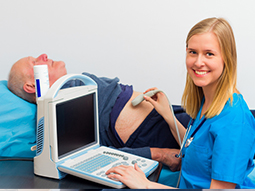The abdominal wall protects the abdominal cavity, where major organs, such as the stomach, kidneys, and small intestine, are located. The muscles of the abdominal wall extend from the front of the body to the sides and wrap around to the back of the body, where they connect to the vertebrae and the hip bones.
Also called a lumbar hernia, a flank hernia is a rare type of hernia that develops as a result of a weakness in the posterolateral abdominal wall, the region that lies on the side and back of the abdominal wall. These types of hernias are rare, but typically occur in older patients between the ages of 50 and 70 years old and are more common in men.
Symptoms of flank hernia
This type of hernia may go unnoticed in the early stages. Symptoms commonly experienced by patients with a flank hernia include:
- A bulge on the back or side of the abdomen
- Back pain around the area of the bulge
- Pain that worsens when coughing and/or straining
Causes
They are typically the result of blunt force trauma to the abdominal wall. However, they can also occur due to weakness in the abdominal muscles after a surgical incision. Sometimes, the tissues that were cut while making a surgical incision do not heal completely after the procedure. When this happens, a gap forms. This gap leaves the patient susceptible to hernia formation.
There are also other factors and conditions that may put an individual at risk, including:
- Force trauma to the abdominal wall
- Weakness in abdominal muscles after surgery
- Musculoskeletal defect at birth
- Older age
- Repetitive strenuous activity
- Losing weight too quickly
- Wound infection
What to expect at your appointment
During your appointment, your doctor will ask you questions about your symptoms and will perform a physical examination. In order to make a definitive diagnosis and assess the severity of the hernia, your doctor may prescribe one of the following diagnostic techniques:
- MRI scan
- CT scan
- Ultrasound imaging
Additionally, your doctor may want to check for any signs of infection by prescribing a blood or a urine test.
Treatments
Non-surgical Treatments
These do not heal on their own and can cause serious health complications if left untreated. Surgical intervention is required to repair.
Surgical Treatment and Post-Treatment
Due to the location of flank hernias, surgical treatment tends to be more complex compared to surgical treatments for other types of hernias. For this reason, surgeons may recommend open repair, instead of laparoscopic repair, in order to be able to address larger, more complex flaws in the abdominal wall. Additionally, open repair allows surgeons to place mesh on the inner and outer sides of the hernia, providing more stable wound closure.
Following repair, patients will be required to stay in the hospital for a few days. The length of the hospital stay will depend on the patient’s overall health and the complexity of the surgery. Patients may be able to return to daily activities about three weeks after the operation. However, strenuous activities should be avoided for at least six weeks.
Our providers

Expert hernia care
Getting the care you need starts with seeing one of our hernia specialists.









